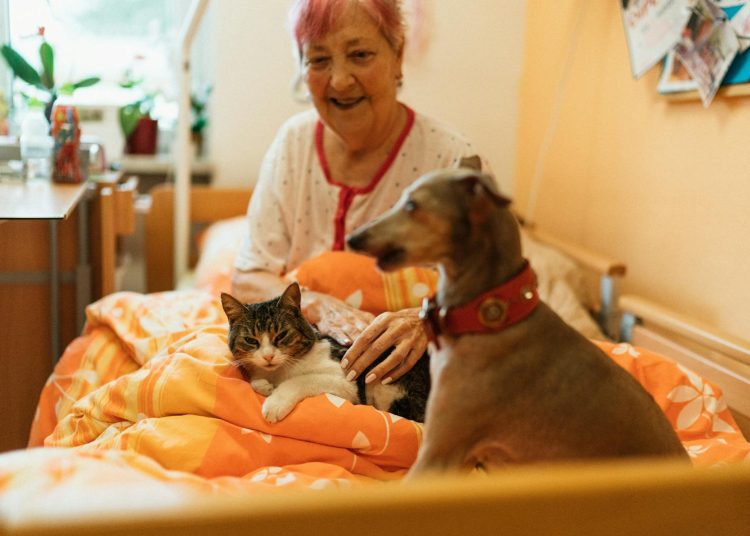As pets grow older, their grooming needs change. Senior pets, just like senior humans, often require extra care and attention to ensure their comfort and health. Grooming a senior pet is not just about keeping them looking nice—it’s about addressing their specific physical needs, monitoring their health, and providing them with the comfort they deserve in their golden years. This guide offers insights and practical tips for grooming your aging companion to ensure they stay happy, healthy, and comfortable.
1. Why Grooming Is Important for Senior Pets
Grooming is a crucial aspect of maintaining your pet’s overall health, and this becomes even more important as pets age. Senior pets may experience physical changes such as arthritis, reduced mobility, and weakened immune systems, which can affect their skin, coat, and overall grooming needs. Regular grooming not only keeps their coat and skin healthy but also allows you to spot any unusual changes, such as lumps, sores, or changes in their coat texture, early on.
Grooming also provides an opportunity to bond with your senior pet. Gentle grooming sessions can be soothing, helping your pet relax and enjoy the interaction, especially if they have become less active or more anxious in their older age.
2. Brushing: Keeping the Coat Healthy
Brushing is an essential grooming activity for senior pets. As pets age, their coats may become thinner, drier, or more prone to matting. Regular brushing helps remove loose fur, dirt, and debris while stimulating natural oil production that keeps the skin and coat healthy.
- Frequency: Brush your senior pet at least once or twice a week, depending on their coat type. Long-haired pets may need more frequent brushing to prevent tangles and mats, which can be uncomfortable or even painful.
- Tools: Use a soft-bristle brush or a grooming mitt for gentle brushing. Senior pets may have more sensitive skin, so avoiding harsh brushes can prevent irritation. Be gentle and patient, taking care to avoid pulling on any tangles.
3. Bathing Considerations for Senior Pets
Bathing a senior pet can be challenging, especially if they have arthritis or mobility issues. It’s important to ensure that bathing is a comfortable experience for them, without causing unnecessary stress or physical strain.
- Bathing Frequency: Senior pets do not need to be bathed as frequently as younger pets. Bathing every 6-8 weeks is generally sufficient, unless they become dirty or have a specific skin condition that requires more frequent bathing.
- Bath Setup: Use a non-slip mat in the tub to provide stability, and ensure the water is lukewarm—not too hot or cold. If your pet has trouble standing, consider using a handheld showerhead or a cup to gently pour water over them while they sit or lie down comfortably.
- Shampoos: Use a mild, moisturizing shampoo specifically formulated for pets. Senior pets are more prone to dry skin, so a gentle shampoo with moisturizing properties can help keep their skin from becoming too dry.
4. Nail Trimming: Avoiding Overgrowth and Discomfort
As pets age, their activity levels may decrease, leading to less natural wear on their nails. Overgrown nails can cause discomfort, affect their gait, and even lead to joint problems if not addressed.
- Regular Trimming: Trim your senior pet’s nails every 3-4 weeks to keep them at a comfortable length. If you are unsure about trimming their nails, ask your veterinarian or a professional groomer for help.
- Gentle Handling: Senior pets may have more fragile joints, so handle their paws gently during nail trimming. If your pet seems uncomfortable, try trimming just one or two nails at a time and rewarding them with treats before continuing.
5. Ear Care for Senior Pets
Senior pets can be more prone to ear infections, especially if they have floppy ears that can trap moisture and debris. Regular ear care is essential to prevent infections and keep your pet comfortable.
- Checking the Ears: Check your pet’s ears once a week for signs of redness, odor, or excessive wax buildup. Use a vet-approved ear cleaner and a cotton ball to gently clean the outer part of the ear.
- Signs of Infection: If you notice your pet shaking their head, scratching at their ears, or if there is a foul odor, consult your veterinarian. These could be signs of an ear infection that requires medical attention.
6. Dental Care: Maintaining Oral Health
Dental health is crucial for senior pets, as poor oral hygiene can lead to pain, tooth loss, and other health problems, including heart and kidney disease. Regular dental care is essential to keep your pet’s mouth healthy.
- Tooth Brushing: Brush your pet’s teeth several times a week using a pet-specific toothbrush and toothpaste. Senior pets may be more resistant to brushing, so start slowly and be gentle. If brushing is not possible, consider using dental wipes or water additives to help reduce plaque.
- Dental Checkups: Schedule regular dental checkups with your veterinarian. Professional cleanings may be necessary to address tartar buildup and prevent dental disease.
7. Skin and Coat Health: Addressing Age-Related Changes
As pets age, their skin may become drier, and their coat may lose its luster. Paying attention to their skin and coat health can help keep them comfortable.
- Moisturizing Shampoos: Use moisturizing shampoos and conditioners to prevent dry, flaky skin. Oatmeal-based products can be especially soothing for senior pets.
- Monitor for Lumps and Bumps: Senior pets are more likely to develop lumps and bumps on their skin. During grooming sessions, check for any new or unusual growths and consult your veterinarian if you find anything concerning.
8. Managing Arthritis and Mobility Issues During Grooming
Many senior pets experience arthritis or reduced mobility, which can make grooming more challenging. It’s important to adapt your grooming routine to accommodate their needs.
- Comfortable Positioning: Allow your pet to lie down or sit comfortably during grooming sessions. Grooming tables with padding or placing a soft mat on the floor can help keep your pet comfortable.
- Short Grooming Sessions: Keep grooming sessions short to avoid causing discomfort or fatigue. Break grooming tasks into smaller steps if needed, and always reward your pet with treats or praise to make the experience positive.
9. Maintaining a Stress-Free Grooming Routine
Senior pets can become more anxious with age, especially if they have developed vision or hearing impairments. Maintaining a calm and stress-free grooming routine is essential for their well-being.
- Set a Routine: Establish a consistent grooming routine so your pet knows what to expect. This predictability can help reduce anxiety.
- Use Positive Reinforcement: Reward your pet with treats, gentle petting, and praise during and after grooming. Positive reinforcement can make grooming a more enjoyable experience for your senior companion.
- Be Patient: Senior pets may need more time to adjust to grooming. Be patient and gentle, allowing them to take breaks if they seem uncomfortable or restless.
10. When to Seek Professional Grooming Assistance
While many grooming tasks can be managed at home, there are times when professional grooming is necessary, especially for senior pets with special needs. Professional groomers are experienced in handling older pets and can provide services such as clipping, bathing, and nail trimming in a way that minimizes stress.
- Health Monitoring: A professional groomer can also help identify potential health issues during grooming sessions, such as skin infections, dental problems, or joint pain, and recommend veterinary care if needed.
- Mobile Grooming: If your senior pet has difficulty traveling, consider using a mobile grooming service. Mobile groomers come to your home, which can be less stressful for pets with mobility issues or anxiety about car rides.
Grooming your senior pet with care and attention can help keep them comfortable and improve their quality of life. With the right approach, grooming can be a time of bonding and relaxation, ensuring that your aging companion feels loved and well cared for in their golden years.








